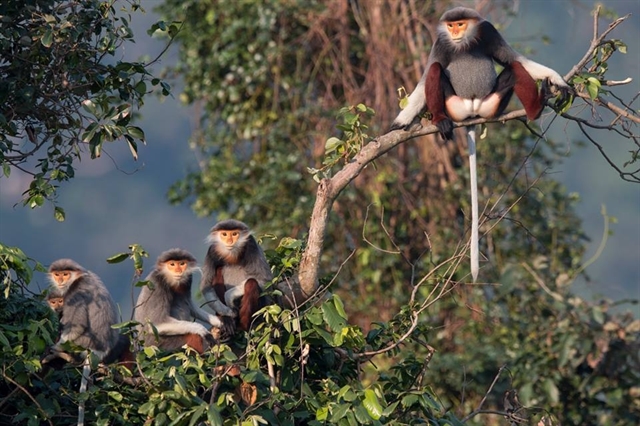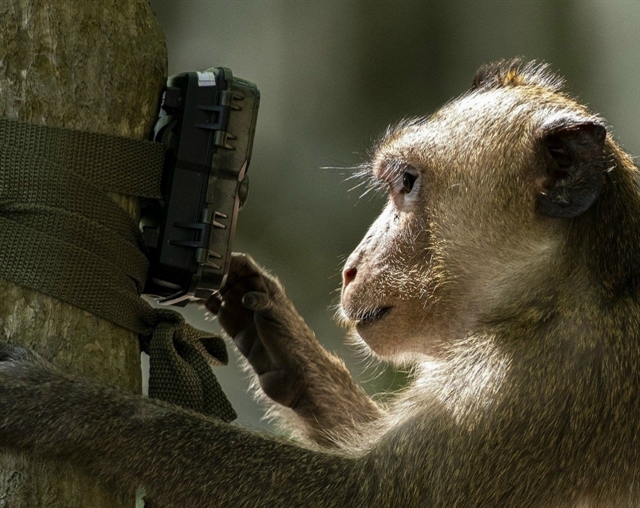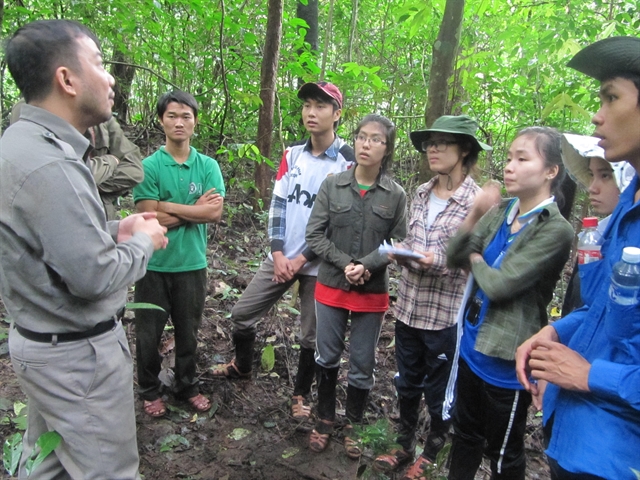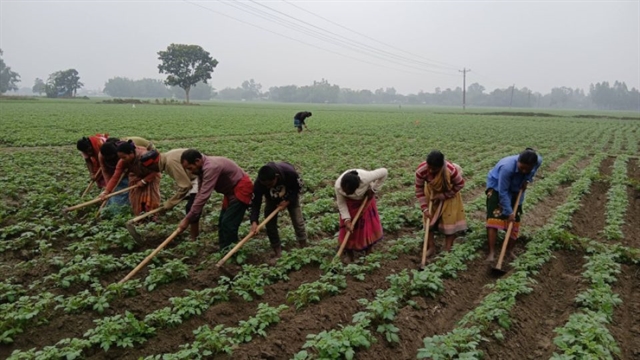 Features
Features

Beginning his primate conservation research in 1999, Dr Hà Thăng Long, a natural conservationist, helped build a network of biodiversity researchers and expanded conservation projects in central Việt Nam.
by Công Thành

|
| A family of red-shanked douc langurs (Pygathrix nemaeus) seen at Sơn Trà Nature Reserve in Đà Nẵng. Primate conservation in central Việt Nam helps conserve the rich biodiversity for research. — Photo courtesy of GreenViet |
Beginning his primate conservation research in 1999, Dr Hà Thăng Long, a nature conservationist, helped build a network of biodiversity researchers and expanded conservation projects in central Việt Nam.
Long, 46, one of the leading primates researchers in Việt Nam, has helped train hundreds of students in biodiversity during annual field trips to the forests in the central region.
"Forests in the region provide a safe home to 16 primates species including langurs, gibbons and monkeys. Nature reserves in the region are much-favoured places for watching endangered langur families. Visitors can see a herd of 50 red-shanked douc langurs (Pygathrix nemaeus) – the largest in Việt Nam – in the Sơn Trà Nature Reserve in Đà Nẵng at close range at any time," he said.
.jpg)
|
| A biologist visits a wildlife rescue centre in Gia Lai Province in the Central Highlands. — VNS Photo Công Thành |
Long, head of the representative office of the Frankfurt Zoological Society, said reserves in the Central Highlands naturally formed a close linkage with other provinces creating transquil 'safe' corridors and habitat for wildlife and primates species.
“Reserves in Ninh Bình, Hà Nam, Nghệ An, Quảng Bình, Hà Tĩnh, Quảng Trị, Thừa Thiên Huế, Đà Nẵng, Quảng Nam, Quảng Ngãi and Central Highlands provinces of Kon Tum, Gia Lai naturally link to each other, which helps primates and wildlife species exchange and move easily and safely,” he said.
A report from the Vietnamese Journal of Primatology – a peer-reviewed open access journal – showed that Việt Nam, with 25 primate taxa, is home to the highest number of primate species on the Southeast Asian mainland. Nevertheless, with 90 per cent of the primate species in Việt Nam threatened with extinction, the country is no exception to the ongoing global biodiversity collapse.
Long, who is the founding chairman of the Centre of Biodiversity Conservation (GreenViet), said the very first research at the Cúc Phương Endangered Primate Rescue Centre, a long-term strategy on biodiversity and langur conservation, had been expanded in national parks and nature reserves in Ninh Bình, Quảng Bình, Khánh Hoà, Gia Lai, Đắk Lắk and Kon Tum since 1991.
"Việt Nam is the only site globally where the endangered grey-shanked douc langurs have been conserved. Núi Thành District in Quảng Nam is a very new interesting site – where the local community had voluntarily protected herds of 50 critically endangered langurs for 25 years before local authorities officially listed the conservation plan."

|
| A monkey looks at a camera in the jungle. Many conservation projects have been built to protect endangered wildlife species in central Việt Nam. — Photo courtesy of Bùi Văn Tuấn. |
Conservationist Trần Hữu Vỹ, director of GreenViet, said conservation research in the central region had gradually helped improve awareness among communities living in the region's buffer zone of nature reserves and parks.
"Conservationists and biologists from GreenViet have been working at seven nature reserves and national parks to protect rich diversity and about 2,400 endangered langurs. Experts from the NGO also help train 80 rangers annually with biodiversity research and data collection," Vỹ said.
Future conservationists
Vỹ said more than 300 students had been trained in biodiversity in the park since 2006, supplying staff for primate and biodiversity conservation nationwide.
He said at least 50 per cent of the population living around reserves and national parks had improved their awareness of illegal hunting and logging from community education projects that GreenViet included in primate conservation and research programmes.
"Our research and studies programmes on the primates and biodiversity contributes data and reference information for other researchers on fauna and flora conservation in Việt Nam and globally."
Biologists from GreenViet were the first in Việt Nam to provide an official report on the existence of 1,300 red-shanked douc langurs in the Sơn Trà Nature Reserve in 2017.

|
| Young students join a field trip in the jungle. Biodiversity research needs the involvement of younger generations for long-term conservation of nature in Việt Nam. — VNS Photo Công Thành |
GreenViet had trained more than 28,000 teachers, primary school students, and residents in nature and the langurs in Đà Nẵng over the years.
It also built a 'nature school' at the Sơn Trà Reserve for field trips of primary school students, parents, teachers, and tourists exploring the primaeval forest and population of the endangered red-shanked douc langurs.
The head of the school, biologist Nguyễn Thị Tịnh, said it offered education on biodiversity, first-hand experience in forest research and outdoor skills and a chance to explore the lifestyle of the red-shanked douc langurs.
"Children living in urban areas rarely have an opportunity for jungle trekking and observing the wildlife. The first forest school in central Việt Nam will help children build up their love of the forest and wildlife and natural experiences," Tịnh said.
"Kids and their parents will come to experience 'forest bathing' with jungle trips, raising ideas on forest restoration and wildlife protection from a young age. They will be the first 'forest-educated' students in central Việt Nam following conservation studies in the future."
Crop expansion
Việt Nam's rich biodiversity has been under threat due to over-exploitation, illegal wildlife hunting and trafficking, and poor management and collaboration of state agencies.
Deputy General Director of the Việt Nam Administration of the Forestry Cao Chí Công said that many policies were built in the past years. However, it was still a challenge to manage and protect biodiversity and endangered flora and fauna at national nature reserves and parks.
The expansion of coffee, pepper and cashew farms have encroached on forest areas, narrowing wildlife habitat.
According to the latest report from the agriculture ministry, the current coffee farming area (583,000ha) exceeds the 2020 plan (530,000ha), while forested areas account for just 2.5 million hectares (45.8 per cent) of the Central Highlands region.
Each year, the region loses 34,000ha of forest due to illegal logging and land clearance for short-term profitable crops such as coffee, rubber or acacia.
The ministry also said the forested area had dropped by 180,000ha, of which 112,000ha had been destroyed or occupied by the expansion of other crops' plantations, and 37,000ha for building hydro-power plants and roads between 2010-15.
Dr Long suggested that agriculture in the region should focus on increasing added value farm produce rather than expanding plantation areas.
"Coffee and acacia plantations could use technology to improve quality and output, but not clear forest areas for short-term harvests. Farmers would have one small area to plant high-quality crops for higher profit, rather than spending more work on larger farms," Long said.

|
| Dr Hà Thăng Long (left), a leading langur researcher in Việt Nam, gives a lecture in the jungle for students in a field training course in Kon Ka Kinh National Park. More than 300 students have been trained in biodiversity protection and research. — VNS Photo Công Thành |
"Forest areas will have a 'safe shelter' for the endangered primates and wildlife species to grow in peace. Human activities and negative impacts (illegal hunting and logging) will be stopped on the boundary of farms and forest," he said. "It's a positive co-existence for both humans and wildlife." — VNS




